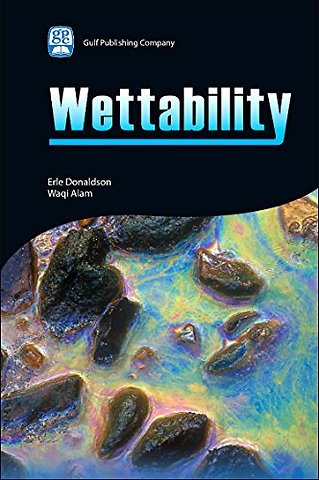<br>Preface</br><br>Nomenclature</br><br>About the Authors</br><br>1 Wettability</br><br> The Four States of Wettability</br><br> Water-Wet System</br><br> Fractionally-Wet</br><br> Mixed-Wet</br><br> Oil-Wet</br><br> Interfacial Tension</br><br> Contact Angle</br><br> Advancing and Receding Contact Angles</br><br> Core Preservation</br><br> Capillary Pressure</br><br> Amott Wettability Index</br><br> Combined Amott-USBM Wettability Test</br><br> Spontaneous Imbibition</br><br> Oil Recovery by Imbibition</br><br> Spreading</br><br> Effect of Wettability on Relative Permeability</br><br> Effect of Wettability on Waterfloods</br><br> Procedures</br><br> Production Curves</br><br> Effects of Viscosity</br><br> Effects of Wettability on Electrical Properties</br><br> Dispersion and Wettability</br><br> Introduction</br><br> Applications</br><br> Theory</br><br> Influence of Wettability</br><br> Example Problems</br><br>2 Surface Forces</br><br> Introduction</br><br> Van der Waals Equation of State</br><br> Electrostatic Interactive Energies</br><br> Dielectric Media</br><br> Principle Interactive Forces</br><br> Short-Range Forces</br><br> London Dispersion Forces</br><br> Dipole Forces</br><br> Keesom Dipole-Dipole Forces</br><br> Debye-Induced Dipole Interactions</br><br> Van der Waals Forces</br><br> Zeta Potential and the Electric Double Layer Interaction</br><br> DLVO (Derjaguin, Landau, Verwey, and Overbeek) Theory</br><br> Hamaker Constant</br><br> Disjoining Pressure</br><br> Electrostatic Forces</br><br> Poisson-Boltzman Equation</br><br> Counterion Density with Respect to Distance (Diffuse Double Layer)</br><br> Osmotic Repulsion Pressure</br><br> Hydration Forces</br><br> Disjoining Pressure and the Canonical Potential</br><br> Hydrogen Bonding</br><br> Summary of Interactive Forces</br><br> Lewis Acid/Base Reactions</br><br> Solvent Behavior</br><br> Solid Surface Interactions with Solutions</br><br> Clay Swelling and Particle Movement</br><br> Crude Oil/Solid Surface Interactions</br><br> Example Problems</br><br>3 Wettability and Production</br><br> Introduction. Origin and Accumulation of Hydrocarbons</br><br> Petroleum Traps</br><br> Primary Migration</br><br> Secondary Migration</br><br> Buoyant Forces</br><br> Capillary Forces</br><br> Earth Tides and Secondary Migration</br><br> Accumulation of Hydrocarbons in Traps</br><br> Subsurface Environment</br><br> Pore Surface Properties</br><br> Multiphase Flow</br><br> Vertical Saturation Profile</br><br> Fractured Reservoirs</br><br> Mobility Ratio</br><br> Fractional Flow Equation</br><br> Frontal Advance Equation</br><br> Impact of Wettability on Waterfloods</br><br> Example Problems</br><br>4 Pore Size Effects and Wettability Alteration</br><br> Introduction</br><br> Porosity</br><br> Pore Structure</br><br> Pore Texture</br><br> Sandstones</br><br> Carbonate Rocks</br><br> Pore Size Distribution</br><br> Permeability from Pore Size Distributions</br><br> Carman-Kozeny Equation</br><br> Flow Properties of Porous Media</br><br> Wettability Alteration</br><br> Polar Compounds in Crude Oils</br><br> Alkaline Compounds</br><br> Capillary Number</br><br> Surfactants</br><br> Wettability Alteration Caused by Microbes</br><br> Chemistry of Silica Sand</br><br> Chemistry of Limestone, Chalk and Dolomite</br><br> Properties of Crude Oils that Affect Wettability</br><br> Asphaltene Solvency of Crude Oils</br><br> Adsorption on Reservoir Rocks</br><br> Summary and General Conclusions</br><br> Example Calculations</br><br>5 Practical Applications of Wettability</br><br> Introduction</br><br> Wettability and Primary and Secondary Recovery Efficiency</br><br> Wettability and Tertiary Recovery Efficiency</br><br> Thermally-Induced Wettability Alteration for Improved Recovery</br><br> Ghaba North Field</br><br> Qarn Alam Field</br><br> Preventing Adverse Wettability Shift during Enhanced Recovery Process</br><br> Field Test of the CaCO3 Deposition Process at Elk Point Thermal Pilot</br><br> Improved Oil Recovery by Altering Wettability by Chemical Injection</br><br> Determination of Applicability of Wettability Reversal</br><br> Effect of Drilling and Completion Fluids on Wellbore Wettability and Its Stability</br><br> Minimizing Formation Damage by Controlling Wettability</br><br> Example Problems</br><br>6 Fortran Computer Programs</br><br> Introduction</br><br> Dispersion</br><br> Two-Phase Fractional Flow</br><br> Pore Size Distribution</br><br> Pores Size Distribution</br><br> Permeability Estimation</br><br> Relative Permeability</br><br> USBM Wettability Index</br><br>A Front Tracking Program</br><br> Introduction</br><br>Bibliography</br><br>Index</br><br></br>

